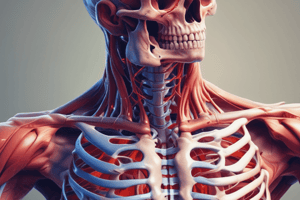Podcast
Questions and Answers
Which type of joint allows for the least amount of movement?
Which type of joint allows for the least amount of movement?
- Sutures (correct)
- Synovial joints
- Fibrous joints
- Cartilaginous joints
Which type of muscle is responsible for voluntary movement?
Which type of muscle is responsible for voluntary movement?
- Skeletal muscles (correct)
- Cardiac muscles
- Tendinous muscles
- Smooth muscles
What type of tissues are muscles primarily composed of?
What type of tissues are muscles primarily composed of?
- Fibrous tissues
- Elastic tissues (correct)
- Vascular tissues
- Rigid tissues
Which component of the skeletal system is responsible for holding bones together without allowing much movement?
Which component of the skeletal system is responsible for holding bones together without allowing much movement?
What is the function of bursae in synovial joints?
What is the function of bursae in synovial joints?
Which of the following statements about compact bone tissue is correct?
Which of the following statements about compact bone tissue is correct?
Which of the following is NOT a function of cartilage?
Which of the following is NOT a function of cartilage?
Which type of cartilage covers the ends of bones where they meet other bones, forming the joint surfaces?
Which type of cartilage covers the ends of bones where they meet other bones, forming the joint surfaces?
What is the primary function of ligaments?
What is the primary function of ligaments?
Which of the following statements about tendons is correct?
Which of the following statements about tendons is correct?
Study Notes
Anatomy is the study of the structure of organisms and their parts. One essential aspect of human anatomy is the skeletal system, which includes all bones, cartilages, ligaments, tendons, joints, and muscles. Let's delve deeper into these components:
Bones
Bones are hard, rigid organs that give shape and support to the body. They also protect vital organs such as the brain within the skull and the heart within the ribcage. There are two types of bone tissue: compact and spongy. Compact bone tissue is solid and dense, making up approximately 80% of total bone mass. Spongy bone has a honeycomb-like structure and can be found near joints, allowing for growth and repair.
Cartilages
Cartilages are firm connective tissues with no blood vessels within them. They play several roles in the body, including providing cushioning between bones, supporting weight-bearing areas like the ears and nose, and forming structures like the more flexible joints in the limbs. A major type of cartilage is hyaline cartilage, which covers the ends of bones where they meet other bones, forming the joint surfaces.
Ligaments
Ligaments are elastic fibrous bands connecting one bone to another, serving to stabilize and secure the bones together. These strong, flexible cords help to prevent excessive movement between bones and thus maintain stability in joints.
Tendons
Tendons are thick bands of tough, fibrous tissue that connect muscle to bone. Through this connection, when we contract our muscles, it pulls on the tendon, causing precise movements through various points of attachment. This allows us to move around and interact with our environment.
Joints
Joints are points where two bones meet and allow motion between them. There are three main types of joints: synovial joints, sutures, and fibrous joints. Synovial joints have fluid-filled sacs called bursae that lubricate the joint, allowing for smooth movement. Sutures join the flat bones of the skull and do not allow any movement. Fibrous joints, like those found in the clavicle, hold bones together without allowing much movement.
Muscles
Muscles are soft, elastic tissues capable of contracting forcefully and pulling upon bones, enabling movement and maintaining posture. There are three types of muscles: skeletal, cardiac, and smooth. Skeletal muscles respond to nerve impulses from the central nervous system and allow for voluntary movement. Cardiac muscles control the heart's rhythmic contractions. Smooth muscles help regulate digestion, respiration, and other processes throughout the body.
In conclusion, the skeletal system plays a crucial role in maintaining our physical integrity. It provides support, protection, and facilitates movement. Understanding its components - bones, cartilages, ligaments, tendons, joints, and muscles - helps us appreciate how each part contributes to the overall functioning of our bodies.
Studying That Suits You
Use AI to generate personalized quizzes and flashcards to suit your learning preferences.
Description
Explore the essential components of the human skeletal system, including bones, cartilages, ligaments, tendons, joints, and muscles. Learn about their structure, functions, and how they contribute to support, protection, and movement in the body.




